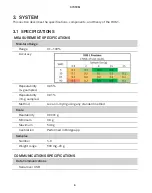
4
OPERATION
b. Do not fill the sample cup more than half full.
Overfilled cups slow down the readings.
3. Wipe any excess sample material from the rim and outside of the sample cup with a
clean KIMWIPES
®
tissue.
Material left on the rim or the outside of the cup can contaminate the carousel and be
transferred to adjacent samples.
4. If a sample cannot be measured immediately, put it in a sealed container until it can be
measured to avoid water loss.
2.3 TAKING A READING
The ROS 1 can test one to nine samples simultaneously. The sample type will determine the
desired test settings: drying temperature, timed test or constant-weight test, and constant-
weight test parameters. Several presets are available.
can help select the
appropriate settings for the sample and a video tutorial is also available at
Use the following steps to take a reading with the ROS 1.
1. Ensure the ROS 1 is plugged in and turned on.
2. In the Bridge app, select the METER USB COM port.
3. Click
Connect
.
4. Select sample test settings in the Bridge app.
5. Open the ROS 1 sample chamber lid.
6. Verify that the sample chamber is clean and free from debris.
If the sample chamber is dirty, please follow the cleaning steps listed in
7. Place empty sample cups in the sample chamber in any of the positions.
NOTE: When drying liquid samples, filter paper may be added to the empty sample cup before taring.
The ROS 1 can take between one and nine sample test at one time. Any position without
a sample cup will be disregarded, meaning all positions on the carousel do not have to
contain a sample cup.
8. Close the sample chamber lid.
NOTE: More accurate weight readings can be achieved by closing the sample chamber lid while weight
measurements are being taken.
9. Click
Next
in the Bridge app window.
The ROS 1 will move the carousel around to detect sample cups and take accurate tare-
weight readings.
NOTE: Both the tare-weight measurement and the sample-weight measurement are critical values for the
calculation of moisture content.






















